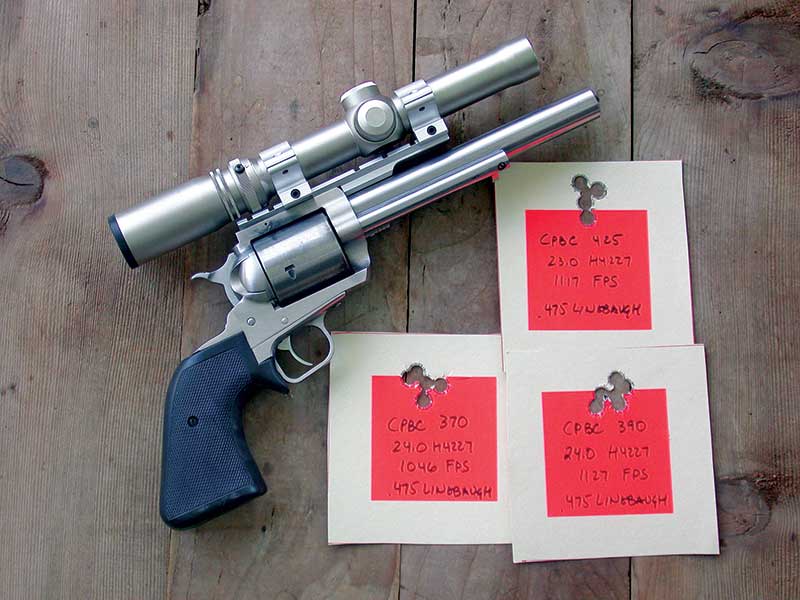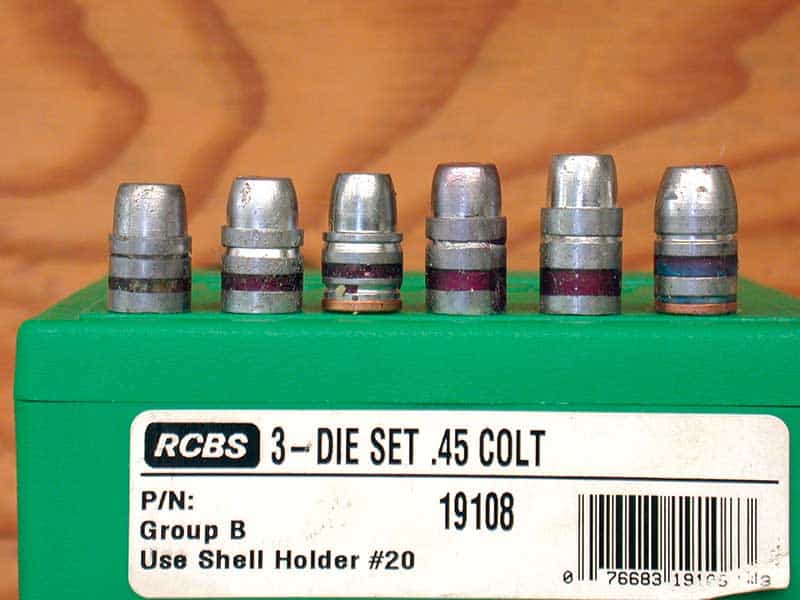Big Bullet Baloney
Some of the first heavyweight bullets for both the .44 Magnum and .45 Colt came from J.D. Jones and SSK Industries. He designed a 320-gr. flat point/truncated cone for the former and a 340-gr. for the latter. For his .454 Casull, Dick Casull came up with a 300-gr. flat-nosed gas check which was catalogued by Lyman as #454627; it also makes an excellent .45 Colt bullet. NEI contributed two excellent .45 Colt bullets Keith-style, #451.310 and #454.325 with the latter numbers giving the approximate weight. NEI also came up with my favorite heavyweight .44 Magnum bullet, a 290 Keith style gas check #429.295.
For the .45 Colt, Dave Scovill designed the RCBS #45-270 which from my wheel weight alloy weigh out at 280 grains. At 930 fps from a 71/2″ .45 Colt SAA, at least until another woolly mammoth is sighted in Idaho, it will handle anything I would expect a Colt Single Action to attempt.
Bigger
With the advent of John Linebaugh’s .475 and .500, bullets in the 370-420 gr. and 370-440 gr. range arrived. The same bullet weights apply to the .480 Ruger, .500 Wyoming Express and even the .500 S&W Magnum. Even at moderate velocities any of these bullets will work for big game, and with full house loads give all the recoil any normal person should want.
Then came the Internet! Suddenly we had a small group of Internet Ninja Warriors calling for heavier and heavier bullets, the purpose of which escapes me. The .500 Smith & Wesson is brutal with full house 440-gr. bullets and some of these people were calling for 750-gr. bullets! An overly heavy bullet like this makes absolutely no sense.
Anymore, for the .44 Magnum I rarely go heavier than 290 gr.; the .45 Colt, 325 gr., and in really big bores I usually stay in the 370-420 gr. neighborhood. Going past these parameters results in more recoil, less muzzle velocity, less penetration, and is definitely harder on the sixgun. Accuracy also reaches the point of diminishing returns as heavier bullet weights outpace the ability of the rifling twist to handle them.
There is also a “Bullet Puller Effect” as we say. With overly heavy bullets a sixgun becomes an expensive bullet puller. Back in the 1980s I did some experiments. I fired all but one round from a .44 Magnum and then replaced the five fired rounds with fresh rounds leaving the one original round in place; I did this two more times. That original .44 Magnum round, no matter what bullet was used, never made it through three cylinder’s full without jumping the crimp and moving far enough forward to lock-up the revolver. This is with standard weight bullets; increase the weight and it happens quicker. It’s easy to arrive at a point with such heavy bullets that the sixgun will be tied up before the first cylinder full is gone. In dangerous game country, that’s deadly.
Good Advice
Randy Garrett makes some of the best ammunition available, concentrating on only the .44 Magnum and the .45-70. He uses 310-330-gr. bullets for the .44 Magnum and no longer recommends the use of his 330-gr. +P Hammerheads for use in the relatively light weight 23/4″ Ruger Alaskan nor the 4″ Redhawk because of the Bullet Puller Effect. For these sixguns he recommends his 310-gr. bullet only, loaded in his Defender ammo at 1,020 fps. Even at this velocity it produces excellent penetration. Randy’s 330-gr. +P Hammerhead .44 Magnum load at 1,400 fps should be considered by handloaders to be the top end.
Another man whose advice I heed is Gary Reeder. Gary says: “There’s not a week that goes by we don’t have at least one or two people call complaining about a lack of accuracy in their revolvers. In every case the problem stems back to one thing, extra heavy bullets. There is apparently a website promoting these extra heavy bullets and also sells them, and these young guys relate extra heavy weight bullets with more power. I get calls from shooters shooting 390-gr. bullets in a .44 Magnum, 525- to 650-gr. bullets in the .500 Linebaugh and in our .510 GNR, people shooting 520-gr. bullets in the .475 Linebaugh and so on. That we haven’t seen a rash of guns blowing up is amazing to me.”
If you happen to be one of those who think extra heavy bullets are cool — they’re not! If you choose to ignore any of the above anything that happens to you and/or your sixgun is of your own choosing!







